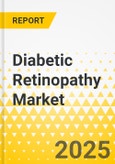This report comes with 10% free customization, enabling you to add data that meets your specific business needs.
The global diabetic retinopathy market is expected to experience substantial growth, with projections indicating a significant increase by 2025 and a steady compound annual growth rate during the forecast period from 2025 to 2035. The rising prevalence of diabetes globally is the primary factor driving the demand for diabetic retinopathy treatments. With advances in anti-VEGF therapies, and laser surgery, the market is seeing considerable growth.
Diabetic retinopathy, which is a leading cause of blindness among diabetic individuals, can be managed effectively with timely intervention. The increasing adoption of advanced diagnostic technologies, such as optical coherence tomography (OCT), has made early detection more accessible, further fuelling the demand for treatments. Moreover, the ongoing research into gene therapies and stem cell-based treatments offers promising avenues for future therapeutic options.
North America is expected to maintain a dominant share of the global diabetic retinopathy market, driven by a high prevalence of diabetes, advanced healthcare infrastructure, and significant R&D investments. Europe is anticipated to experience steady growth, supported by increasing investments in diabetes-related research, well-established healthcare systems, and government initiatives aimed at tackling diabetic retinopathy. In the Asia-Pacific region, rapid growth is expected due to rising diabetes cases, improving healthcare systems, and greater access to advanced diagnostic and treatment options.
Demand: Drivers and Limitations
The demand drivers for global diabetic retinopathy market are:
- The growing elderly demographic is more susceptible to diabetic retinopathy, contributing to market expansion
- Rising awareness about diabetic retinopathy among healthcare providers and patients is leading to earlier detection and treatment
Limitations:
- Advanced therapies, such as anti-VEGF injections and retinal surgeries, are expensive, limiting access, especially in low-income regions
How Can This Report Add Value to an Organization?
Product/Innovation Strategy: This report provides a comprehensive overview of current and emerging trends in the diabetic retinopathy market, highlighting potential areas for product innovation. Companies can leverage insights from this report to explore new therapies and diagnostic technologies, as well as to address unmet needs in patient care.
Competitive Strategy: To maintain a competitive edge, companies should focus on advancing the safety and efficacy of current treatment options, particularly anti-VEGF therapies. Expanding access to cost-effective treatments, fostering collaborations with research institutions, and focusing on the integration of artificial intelligence in diagnostics will be key drivers of success in the market.
Key Market Players and Competition Synopsis
The companies profiled in this report are based on extensive research and insights from primary experts, evaluating company coverage, product portfolios, and market penetration. The leading players in the global diabetic retinopathy market include major pharmaceutical companies and biotechnology firms are actively advancing treatment options and expanding their presence in the market.
Some of the prominent companies established in the global diabetic retinopathy market include:
- Novartis AG
- Apexian Pharmaceuticals
- Bayer AG
- F-Hoffman La Roche
- Kodiak Sciences Inc.
This product will be updated with the latest data at the time of order. Consequently, dispatch time for this product will be 7-10 business days.
Table of Contents
Executive SummaryScope of StudyDefinitionInclusion and Exclusion Criteria
Companies Mentioned
- Novartis AG
- Apexian Pharmaceuticals
- Bayer AG
- F-Hoffman La Roche
- Kodiak Sciences Inc.








